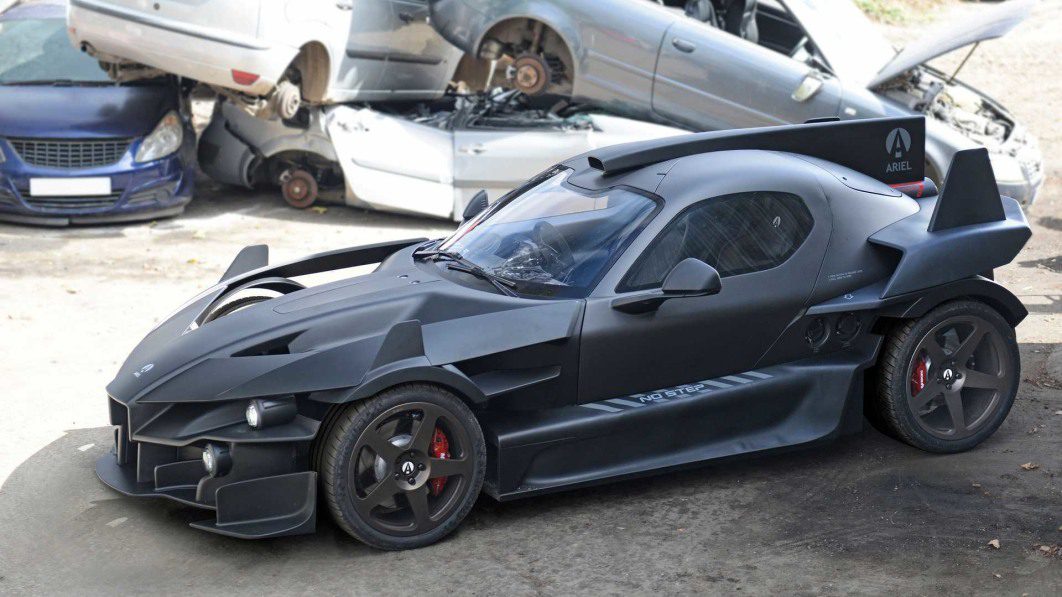Ariel Hipercar is battery-electric, 1,180-hp madness we love

Five years ago, English motorbike- and speedster-maker Ariel showed a new concept chassis called, at the time, the Hipercar. It was planned for sale in 2020 with a gasoline-electric hybrid powertrain built around a small turbine sending electricity to a lithium-ion battery pack and then on to in-wheel motors. Development was more challenging than expected, and the world hit a few rocks in the road as well. But at last, the first production-intent Hipercar prototype is here, still named Hipercar — which stands for “High Performance Carbon Reduction.” The powertrain is easier to explain than the looks, so let’s start there. Base spec would be a liquid-cooled 62.2-kWh battery supplied by Cosworth powering two radial, inboard Equipmake APM motors fitted to the rear axle. Each motor produces 295 horsepower and 332 pound-feet of torque with total output being 590 hp and 664 pound-feet of torque.
An all-wheel-drive version slots two more radial e-motors into the front axle, doubling output to 1,180 hp and 1,328 lb-ft. Range on battery charge alone is said to be 150 miles. On track, Ariel says a full charge should last for about 20 minutes of full-on circuit driving. If desired, buyers can opt for the miniature turbine range extender also sourced from Cosworth. The catalytic generator (CatGen) turbine makes another 47 horsepower and can accept pump fuel, racing fuel and synthetic fuel. Ariel says it’s targeting a 0-60 mph time of 2.09 seconds with this powertrain.
What sits atop all of that is a laser-cut and CNC-folded aluminum tub attached to aluminum subframes front and rear, with aluminum wishbones supporting a Bilstein adjustable suspension. The 20-inch forged or composite staggered wheels wear Michelin Cup2 or Cup2R rubber in the widest spec ever fitted to an Ariel, at 265/35 in front and 325/30 in back. Behind them are 14.5-inch composite brake discs on the front hubs with six-piston AP Racing calipers, and 12.9-inch discs in back with four-piston calipers. An on-off switch controls the regenerative braking system.
As for the body, the prototype wears 3D-printed panels, production models will get a carbon fiber skin. Company boss Simon Saunders said “An enormous amount of aerodynamic work has been carried out for both drag and downforce, and cooling.” The cabin contains rollover protection. The dual-level wing in the front fascia adds downforce, the fins on the front fenders direct air around the side mirrors, the roof scoop sends air to the microturbine, and the fins on the rear fender aid stability. Its long front, stubby back and central fin, and canopy entrance make it reminiscent of the McMurtry Speirling. Total vehicle weight is said to be 3,186 pounds.
The Hipercar’s gestation is almost as wild as the coupe itself. The UK government has thrown huge money behind EV development in an effort to reach its Net Zero goal for carbon emissions by 2050. Obviously, this will require affordable zero-emissions vehicles for the populace, not seven-figure track-day specialists shrink-wrapped to fit two people, so the Hipercar could come off as dumping public money on a fun little lark. However, this is about getting the big guys and the little guys in a room together to figure out how to produce innovations that work on a mass scale. Saunders explained it well to Autocar, saying, “So on one side you’ve got Mr. Boffin who has a high concept for a widget. On the other side, you’ve got, say, Ford Motor Company. They’re never going to talk to him and he’s too scared to talk to them. So Innovate UK is putting money into Ford but it’s also putting money into Mr Boffin, who takes his idea up to the next level, then the next level, and then goes into low-volume widget production. He sells us 100, he sells Caterham 400, he sells 1000 to a coach manufacturer. He’s now making a few thousand. And then Ford might say, “Could you do 10,000 for a low-volume Transit?”
Saunders gave another example of how the Hipercar has challenged the much larger partners in the various groups Ariel is a part of. “I said to Dave Greenwood, the guy running the project for the Warwick Manufacturing Group, that I felt a bit out of place and he said: ‘No, you’re brilliant because you’re the worst case scenario; you want most performance, least weight, highest range, you haven’t got any money for tooling and you want it really cheap, so if we can satisfy you….’
“Eventually, the aim is that we all win. Before then, the Hipercar is about two years away, aimed at a monied few for a price no more precise at the moment than “under £1 million” ($1.2M U.S.). That will be “excellent value for money” in Saunder’s words, considering the expected performance. Perhaps better for future owners, Ariel has focused on reliability. “With the [Ariel] Atom and Nomad we give you the keys and say bye-bye,” Saunders said. “We don’t want to see it again until it’s time for service. The same has to be true for Hipercar.”
Related Video:



